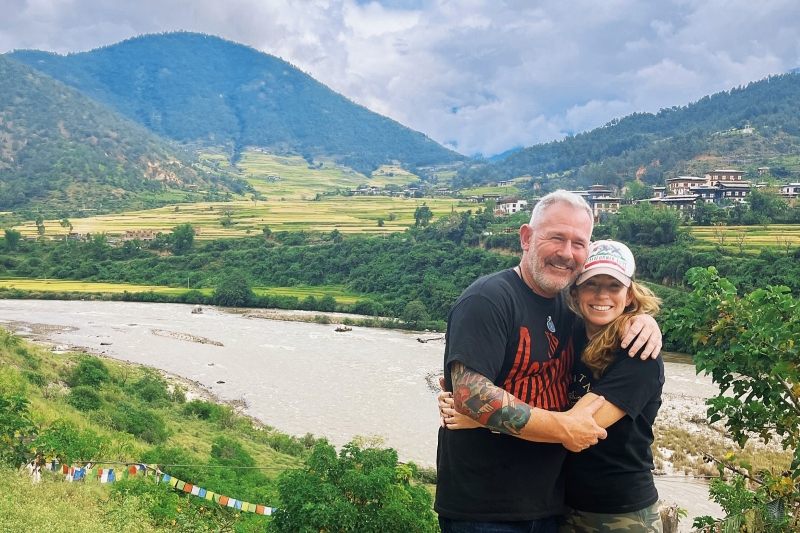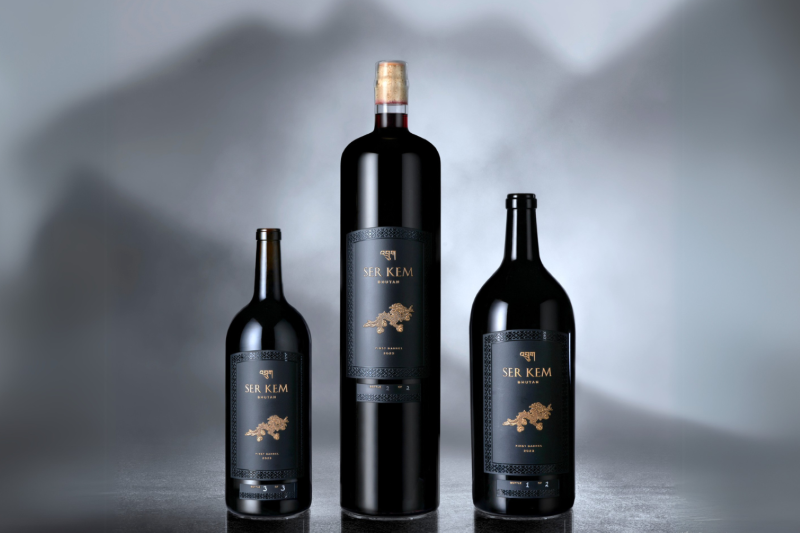
Bhutan is also home to the iconic Tiger’s Nest or Paro Taktsang monastery
Many of the world’s great wine regions begin with the letter “b”. There is Bordeaux and Burgundy in France, of course, as well as the Barossa Valley in South Australia, Burgenland in Austria and even the villages and communes of Italy, like Barolo in Piedmont and Bolgheri in Tuscany. Mention Bhutan, however, and chances are someone would unwittingly choke on their freshly decanted Barbaresco.
Nonetheless, unsettling factors such as climate change, economic fluctuations and even pernickety palates might turn mondo vino on their laurelled heads by introducing not just a newcomer winery or wine region but a winemaking country altogether — an utter and complete palaver considering no recently developed wine region has been cultivated in over a century. What more in the Himalayas!
As European winemakers continue to face the very possible reality that their terroir might soon prove unsuitable for growing grapes (French champagne houses have long cottoned on to this fact, with august maisons like Taittinger already future-proofing themselves by buying up swathes of land across the English Channel in Kent due to temperatures in the southeast of England being comparable to those of the Champagne region 50 years ago), two adventurous Americans decided to take the even bolder step of setting up the Bhutan Wine Company.
On the unprecedentedly gutsy move, Mike Juergens, one of the founders, sparkily replies: “Go big or go home, right? But the reality was I felt extremely passionate that the Bhutanese were missing an opportunity to make some of the world’s greatest wine and strongly believed they should do so.” He consequently wrote the initial white paper, a 10-year business plan and then drafted the proposed wine regulations for the country. “It was all done with the idea that they should do it, and that I would love to come experience it with them when they are ready.”
ann_and_mike_oct_22.jpg

Sure enough, Bhutan rallied and Juergens was soon approached with the option of partnering with them to make it happen. “We were two things. First, flabbergasted. Second, 110% on board for the adventure!”
When Juergens says “we”, he means Ann Cross, his partner both in work and life. Her fascination with the mystical land dates way back. “I was in high school when I read a book about a Canadian woman who had gone to Bhutan to teach English in the 1980s and became enamoured of the country she described,” she says. “After meeting Mike, I told him a million times how much I wanted to visit. Around that time, we were running obscure marathons around the world when he got an email from one of his running lists about the opportunity to run in Bhutan. He signed us up in 2017 as a surprise for me. He did not know anything about Bhutan then and certainly had no intention of starting a winery, let alone a whole industry.”
Those curious about rules and regulations on foreigners living and working in the remote kingdom would be keen to know that a partnership with a Bhutanese citizen is necessary before any business venture may be carried out. “We had befriended an American who had been doing projects in Bhutan for a decade or so. He introduced us to Karma Choeda, who helped us initially promote the idea within the country, and then Karma brought in Yab Dhondup Gyaltshen as a second partner to help us advance the project. While the visitation rules can be important for people there on tourist visas, once a foreign direct investment legal entity has been established, the rules and requirements are different. We have found it extremely easy to do business in Bhutan, more so once we established our FDI entity,” Juergens says.
The Bhutan Wine Company now has 35 full-time employees and another 60-plus seasonal workers. With regards to the permanent facility of the world’s first Bhutanese winery, Cross shares they are still figuring things out. “We have vineyards planted from 150m up to over 2,700m in elevation. We continue to learn about the myriad microclimates there and currently have 200 acres of vineyards, with plans to expand to 2,000 acres over the next seven years. There will still be a lot of experimentation to do and learn from. We have a production facility in Thimphu that will serve us through the next two years and are in the process of evaluating sites for a permanent production facility and winery in the south.”
bhutan_wine_company_paro_vineyard_in_summer.jpg

Nine varietals of red have been planted, including all the usual suspects — Pinot Noir, Syrah, Cabernet Sauvignon, Cabernet Franc, Malbec, Tempranillo, Sangiovese, Merlot and Grenache. There are also five whites — Sauvignon Blanc, Riesling, Chardonnay, Petit Manseng and Chenin — and two hybrids, Traminette and Vidal Blanc.
“Vines were initially imported from France, California and Washington State,” adds Cross. “We have several nurseries in Bhutan and are growing our own vines on their vinifera rootstock. We believe own-rooted vines are better for several reasons, and face no phylloxera issues. So our long-term plan is to be 100% own-rooted vines but may choose to experiment with additional varietals in the future. We are working to explore the expression of each varietal in different microclimates. Likely over the next five years we will primarily focus on certain varietals and reduce their numbers based on microclimate factors on a vineyard-by-vineyard level. For now, we are still trying to understand what works best in which locations.”
Juergens adds: “We are making both single-varietal wines such as Pinot Noir or Riesling, and blends like our classic Bordeaux blend and a Chardonnay/Chenin blend. This is likely to evolve year to year over the next few years, as we are not trying to make a ‘recipe wine’ that meets traditional recipe parameters. For example, in our 2024 vintage we made a Tempranillo/Malbec blend that is amazing, based on the flavours and aromas of those two grapes from that vintage.
“The absence of historical geographic wine laws or traditions provides us the opportunity to really take chances and explore the art of what is possible, and so we anticipate that each vintage will likely generate different wines, blends and single vineyard expressions over at least the next decade.”
Although winemaking is new to the country, Bhutan does have local beer as well as a long, storied culture of making ara, a fermented and sometimes distilled beverage from grains like rice and buckwheat. “Families make their own secret recipe, in many different styles, and the culture supports people coming together to eat and share ara and experiences,” Cross points out. “It is very similar to European wine culture, except that Bhutan never had vitis vinifera, so they utilised cereal grains instead. This makes it much easier for the Bhutan Wine Company to create a wine culture there because we can build upon what already exists, just using vitis vinifera.”
bhutan_wine_bohams.png

For those who think a tipple is incomplete without a nibble, Juergens suggests trying their new Bhutanese whites, particularly the off-dry Riesling, with spicy local dishes. “Our reds are also extremely well balanced, offering crisp acidity and powerful aromatics with a 12.5% alcohol level, which makes them amazing wines for food pairing, adaptive to a variety of food choices. The uniqueness of the Bhutanese terroir allows us to produce wines which have power allied with finesse that provide consumers a food pairing opportunity different from some of the classical pairings. We think that is awesome!”
For Juergens, who fell in love with wine at the age of 22 after sharing a 1975 Gattinara with his father, it would seem as if his wine journey has been nothing short of serendipitous. “After that bottle, I then dabbled as an aficionado for the next dozen years or so before finally getting serious about studying for industry certifications. I’m a Level 2 sommelier with the Court of Master Sommeliers, a certified specialist of wine, and a Stage 2 candidate to become a master of wine. I’ve also written eight books [on the subject] and am the leader of the largest global provider of professional services to the industry via Deloitte’s Winery Solutions and Services.”
Cross, no slouch herself, earned her Wine & Spirit Education Trust diploma in 2018.
“What we are trying to do with the creations of the Bhutan Wine Company is capture the essence of the country in a bottle and share it with the world. We have no definite opinion about what that outcome might be,” Juergens adds.
In Dzongkha, there is a word — sukha — whose Sanskrit origins, not unlike in the Malay language, convey meanings of happiness, pleasure or joy. For Bhutan, a country renowned for prioritising gross national happiness over sole economic growth, it would seem that both Cross and Juergens are perfectly aligned with that vision already.
This article first appeared on Apr 14, 2025 in The Edge Malaysia.


